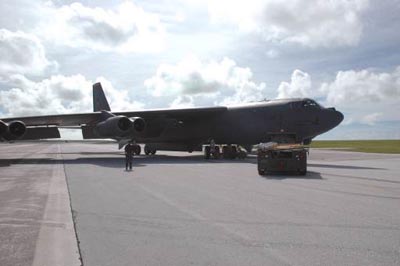Rep eated questioning by lawmakers on an acknowledged gap in stand-off jamming has yielded only two concrete facts: 1) The gap will exist between 2012 and 2015; 2) no one at DOD has a solution yet. The Air Force is revamping its defunct B-52 SOJ program—keeping some technology development and throwing out the staggering $7 billion cost—to produce a cheaper program employing a core component jammer on 30 BUFFs. However, it won’t have that B-52 CCJ capability in hand until 2015, three years after the USAF-Navy EA-6B Prowler MOU runs out. Rear Adm. Bruce Clingan, Navy air warfare boss, told the House Armed Services Air-Land panel last week that the Navy’s new EF-18G Growler, the replacement for the Prowler, “is not the perfect solution” for the gap. He said that a Pentagon joint process will determine whether the US military can “assume the risk associated with that shortfall in capacity.” Lt. Gen. Donald Hoffman, USAF military acquisition deputy, told the panel: “Like all other capability gaps, we will use the other elements of [airborne electronic attack]. … Maybe it takes more risk to the crews that have to operate in this environment. Maybe it is a different [concept of operations] and strategy.”
eated questioning by lawmakers on an acknowledged gap in stand-off jamming has yielded only two concrete facts: 1) The gap will exist between 2012 and 2015; 2) no one at DOD has a solution yet. The Air Force is revamping its defunct B-52 SOJ program—keeping some technology development and throwing out the staggering $7 billion cost—to produce a cheaper program employing a core component jammer on 30 BUFFs. However, it won’t have that B-52 CCJ capability in hand until 2015, three years after the USAF-Navy EA-6B Prowler MOU runs out. Rear Adm. Bruce Clingan, Navy air warfare boss, told the House Armed Services Air-Land panel last week that the Navy’s new EF-18G Growler, the replacement for the Prowler, “is not the perfect solution” for the gap. He said that a Pentagon joint process will determine whether the US military can “assume the risk associated with that shortfall in capacity.” Lt. Gen. Donald Hoffman, USAF military acquisition deputy, told the panel: “Like all other capability gaps, we will use the other elements of [airborne electronic attack]. … Maybe it takes more risk to the crews that have to operate in this environment. Maybe it is a different [concept of operations] and strategy.”
Lt. Gen. Stephen L. Davis, the Department of the Air Force’s top internal watchdog, has been nominated to lead Air Force Global Strike Command, which oversees the service’s bombers and intercontinental ballistic missiles.